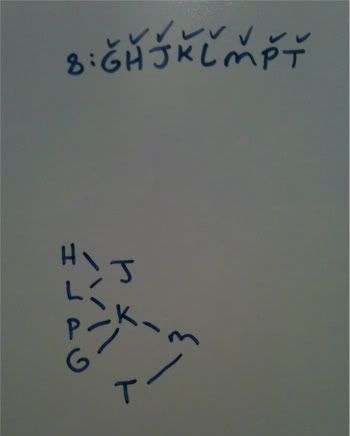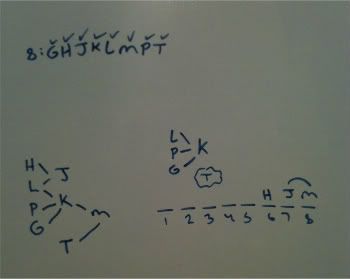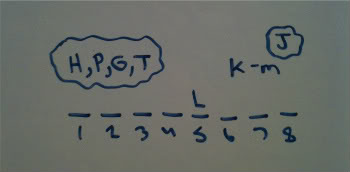Is my setup right for this game (or going in the right direction)?
It took me several attempts to create it, but it feels as if its not going with the questions...
http://i140.photobucket.com/albums/r30/bernag06/Prep48Graph0001.jpg
LSAT Forum
5 postsPage 1 of 1
-

- missbernadette
-
Thanks Received: 0
-
Vinny Gambini

- Posts: 14
- Joined: October 10th, 2009
-

- aileenann
-
Thanks Received: 227
-
Atticus Finch

- Posts: 300
- Joined: March 10th, 2009
Re: PT 48, S2, G2
I think your setup looks just fine, so long as you don't think J and P have a relationship just because you've drawn them close together.
I am guessing you feel this tree doesn't go with the questions because a lot of the questions either ask for or introduce a piece of information of absolute rather than relative position. This happens on tree games, but I would say this tree game has an unusually high number of such questions. When you have a lot of questions talking about relative position, it can sometimes help to draw (in addition to your tree) the slots we usually use for a numbered ordering game. This can help you track position for the questions that ask about absolute position.
For example, let's think about question 8. If M is the seventh field harvest, let's figure out what else we know in terms of absolute position. Well first, we can see that if M is not going last (eighth), then J must be going last because every other element comes before either M or J or both. Therefore, we know that M is 7th and J is 8th, and you could write this into a numbered ordering setup while looking at your tree. I don't think we need to worry about figuring anything else out, because we see J in the answer choices - and we know J certainly cannot be 5th since it must be 8th.
I hope this helps. If there are other specific questions troubling you with this game despite your excellent setup, please follow up with a post and we can work through those questions specifically!
I am guessing you feel this tree doesn't go with the questions because a lot of the questions either ask for or introduce a piece of information of absolute rather than relative position. This happens on tree games, but I would say this tree game has an unusually high number of such questions. When you have a lot of questions talking about relative position, it can sometimes help to draw (in addition to your tree) the slots we usually use for a numbered ordering game. This can help you track position for the questions that ask about absolute position.
For example, let's think about question 8. If M is the seventh field harvest, let's figure out what else we know in terms of absolute position. Well first, we can see that if M is not going last (eighth), then J must be going last because every other element comes before either M or J or both. Therefore, we know that M is 7th and J is 8th, and you could write this into a numbered ordering setup while looking at your tree. I don't think we need to worry about figuring anything else out, because we see J in the answer choices - and we know J certainly cannot be 5th since it must be 8th.
I hope this helps. If there are other specific questions troubling you with this game despite your excellent setup, please follow up with a post and we can work through those questions specifically!
-

- megm7267
-
Thanks Received: 0
-
Jackie Chiles

- Posts: 36
- Joined: November 07th, 2010
Re: Diagram
I'm having a lot of trouble with these questions and my diagram matches the one you approved:
Could you provide a walkthrough of this game? For some reason, I can't even get past number 7. Is this a more difficult tree game?
Could you provide a walkthrough of this game? For some reason, I can't even get past number 7. Is this a more difficult tree game?
-

- megm7267
-
Thanks Received: 0
-
Jackie Chiles

- Posts: 36
- Joined: November 07th, 2010
Re: Diagram
Could I get some help with problems 10-12?
-

- timmydoeslsat
-
Thanks Received: 887
-
Atticus Finch

- Posts: 1136
- Joined: June 20th, 2011
- This post thanked 2 times.

- Most Thanked

- First Responder
Re: Diagram
This is a classic relative ordering game.
Here is my diagram:

Before heading into the questions on relative ordering games, I always consider which variables can go first and which can go last.
I notice that only 2 variables can go last: M and J. So I know that once I place one of those variables in a spot other than 8, I know that the other variable must be 8th.
Question 7
This is a global question asking for what could be true. We will want to use our diagram to eliminate answer choices that we can prove cannot happen. If necessary, we will plug in an answer choice and go from there.
A) J cannot be first. It has 2 variables that must come before it.
B) K cannot be second. It has 3 variables that must come before it.
C) Looks like this could happen. I will hold it for now.
D) G cannot be seventh. It has 2 variables that must come after it.
E) T cannot be eighth. It has 1 variable that must come after it.
Question 8
This is a local question asking us who cannot be 5th if M is 7th.
We know that the only variables that can go last are M and J. If M is going 7th, we know that J must go 8th. So we know that J cannot go 5th. This is our answer.
Question 9
A global question asking us who cannot be 5th. We should use our global diagram to assist us with this question. The easiest way to go about this is to consider the variables that have a lot of variables that must come before it. For instance, M has 5 variables that must come before it. This is our answer. No way could M be 5th.
Question 10
This is a local question asking us what must be true if J is the 3rd field harvested. We know that the only variables that can be last are M and J. If J is 3rd, we know that M must go last (8th). This is our answer.
Question 11
This is a local question asking what must be be true if H is 6th.

This is how I reached that local diagram:
I know that J must come at sometime after H. This leaves one more space to be placed after H. I need to consider which variable could go there. It must be a variable that does not have anyone coming after it since I do not have room for variables to come after it.
This variable must be M. M and J can create a dual option for the 7/8 slots. We must now consider what ordering will take place prior to the 6th slot with the variables left. We have T as a floater on the 1-5 side, as its only rule is that it will come prior to M, and it will necessarily do so no matter where it is placed 1-5. We also still have our ordering of L, P, and G coming before K.
I can now select what must be true on my diagram. And our answer is that K must come at some time before J.
Question 12
This is a local question asking what could be true if L is 5th. This is testing the same concept as the prior question did.

We know that the K-M ordering must come after L. That leaves only one space left among this 6-7-8 slot order. We must consider which variable could be over there without having a variable coming after it. The only variable it can be is J. So we know we have ordering of K-M occurring with J being used as a floater on this side. This is the case due to the rule of J coming after both H and L, and no matter where J is placed in the 6-7-8 slot ordering, it will necessarily do so.
We are now left H, P, G, and T. All of these variables will be considered floaters among slots 1-4. This is the case due to all of these variables will meet the rules given no matter their placement. All of these variables will come prior the variables they are supposed to in the given set up.
So our answer is that M could come before J.
Here is my diagram:

Before heading into the questions on relative ordering games, I always consider which variables can go first and which can go last.
I notice that only 2 variables can go last: M and J. So I know that once I place one of those variables in a spot other than 8, I know that the other variable must be 8th.
Question 7
This is a global question asking for what could be true. We will want to use our diagram to eliminate answer choices that we can prove cannot happen. If necessary, we will plug in an answer choice and go from there.
A) J cannot be first. It has 2 variables that must come before it.
B) K cannot be second. It has 3 variables that must come before it.
C) Looks like this could happen. I will hold it for now.
D) G cannot be seventh. It has 2 variables that must come after it.
E) T cannot be eighth. It has 1 variable that must come after it.
Question 8
This is a local question asking us who cannot be 5th if M is 7th.
We know that the only variables that can go last are M and J. If M is going 7th, we know that J must go 8th. So we know that J cannot go 5th. This is our answer.
Question 9
A global question asking us who cannot be 5th. We should use our global diagram to assist us with this question. The easiest way to go about this is to consider the variables that have a lot of variables that must come before it. For instance, M has 5 variables that must come before it. This is our answer. No way could M be 5th.
Question 10
This is a local question asking us what must be true if J is the 3rd field harvested. We know that the only variables that can be last are M and J. If J is 3rd, we know that M must go last (8th). This is our answer.
Question 11
This is a local question asking what must be be true if H is 6th.

This is how I reached that local diagram:
I know that J must come at sometime after H. This leaves one more space to be placed after H. I need to consider which variable could go there. It must be a variable that does not have anyone coming after it since I do not have room for variables to come after it.
This variable must be M. M and J can create a dual option for the 7/8 slots. We must now consider what ordering will take place prior to the 6th slot with the variables left. We have T as a floater on the 1-5 side, as its only rule is that it will come prior to M, and it will necessarily do so no matter where it is placed 1-5. We also still have our ordering of L, P, and G coming before K.
I can now select what must be true on my diagram. And our answer is that K must come at some time before J.
Question 12
This is a local question asking what could be true if L is 5th. This is testing the same concept as the prior question did.

We know that the K-M ordering must come after L. That leaves only one space left among this 6-7-8 slot order. We must consider which variable could be over there without having a variable coming after it. The only variable it can be is J. So we know we have ordering of K-M occurring with J being used as a floater on this side. This is the case due to the rule of J coming after both H and L, and no matter where J is placed in the 6-7-8 slot ordering, it will necessarily do so.
We are now left H, P, G, and T. All of these variables will be considered floaters among slots 1-4. This is the case due to all of these variables will meet the rules given no matter their placement. All of these variables will come prior the variables they are supposed to in the given set up.
So our answer is that M could come before J.
5 posts Page 1 of 1